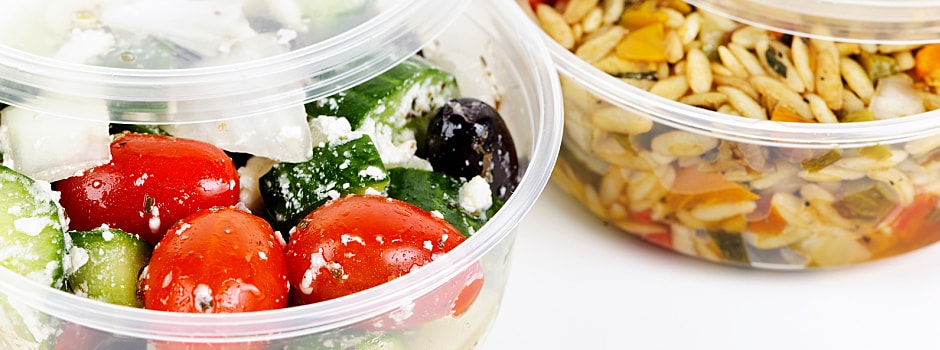Increasingly, guests who might otherwise be in your dining room are opting for prepared meals from their local supermarket or from home-delivery start-ups. Adding ready-to-eat meals to your own menu is a logical response to this lost revenue, but it does raise some food safety issues. Here's how to plan for and manage those additional risks.
Plan Meals
Ready-to-eat meals should tick all the same boxes as your regular menu items. They'll need to appeal to your core clientele, whether that means premium offerings using fresh, local ingredients or relatively low-cost value meals. You should also select ingredients and dishes that reheat well, hold well at serving temperature, and are not unusually perishable. Hollandaise sauce, for example, fails spectacularly on all counts. It's highly perishable, "breaks" easily when held at serving temperature, and its high egg content makes it a potential breeding ground for pathogens. Eggs Benedict is a popular brunch item, but definitely not suited for this format.
Decide Between Hot or Cold Meals
Takeaway meals should be held hot at a food-safe temperature of 140 degrees Fahrenheit or higher, and held cold at 40 degrees Fahrenheit or lower, until they reach the hands of your customer. Hot ready-to-eat meals can go straight to the table with no further preparation, offering instant gratification, which is especially appealing for your lunchtime customers. On the other hand, cold meals can be kept in the refrigerator at home or at work until they're wanted. Each has its advantages, so if you use social media to interact with your guests, ask which they'd prefer. Otherwise, use your best judgment.
Keep Hot Meals Safe
Keeping meals hot is an easy option because you probably have the appropriate equipment, such as a steam table or heat lamps, in use already. As long as you check the temperature of the meals regularly to make sure the food (not the equipment) remains at a safe temperature, you'll be fine. Food quality, rather than safety, will be your limitation. Hot meals deteriorate as they sit around, so set a time limit and discard any that are left unsold. You can manage waste by taking advance orders or by preparing meals in small batches, but food waste should be part of your cost calculations.
Keep Cold Meals Safe
Cold meals may offer more opportunities to get food safety wrong, so they require extra care. As with any dish you prepare in advance, cold meals should be cooled rapidly to remain safe. Divide large batches into smaller portions for faster cooling, use shallow containers with a large surface area, immerse pots in a water or ice bath if necessary, and stir frequently to maximize heat transfer. You may want to assemble and chill complete meals, or cook and cool each component separately, but in either case, monitor the temperature regularly so you know, and can prove, how long it took to reach a safe temperature.
Package Appropriately
One final detail to consider is how you'll package your to-go foods. Hot meals should go into heat-retentive containers, which will help them stay hot and appetizing, and safe, on the trip home. Cold meals last well in flat, shallow packaging, which promotes rapid cooling (for you) and heating (for the customer). Depending on the meal and your clientele, you may want to go with microwave- or oven-safe packaging. When in doubt, ask your customers what works for them.
Advise Your Customers
Not a lot of the guests buying your meals will be trained on food safety or cold-chain management, so help them as much as you can. If the meals will have a printed label, include detailed handling and heating instructions. If that's not an option, you can include bookmark-sized handouts with each meal or have instructions printed inexpensively on napkins or take-out bags. Your website and social media pages also provide opportunities to share food safety information, and you can always link to sources, such as the United States Department of Agriculture's Safe Food Handling Fact Sheets.
Log Everything
Even with all the coaching you can give, some of your customers won't handle their meals properly. They may earnestly believe they were only in the mall for "a few minutes" on the way home, when in reality your carefully chilled meal sat in a sweltering vehicle for two hours. If a food-borne illness ever results from one of your meals, you'll need to show that you did everything correctly on your end. Documenting your procedures and logging food temperatures as you take them can help you prevent future issues.
Related Articles

How to Add a Catering Business to Your Restaurant
Adding a catering business to your restaurant operation can be a very profitable mission. Here are some tips to help you be successful.

High Volume Meets Consistent Quality
Meeting the demands for high volumes, environmental conditions, and turn-key operation

Fast Casual Restaurants: How to Embrace the Trend
While sitting down to enjoy a meal out is something that will never die, fast casual restaurants are growing in popularity. Here are some benefits.



